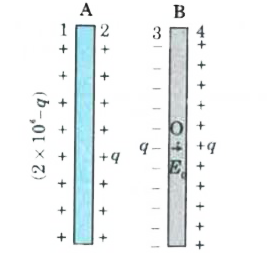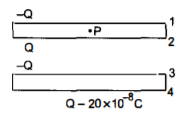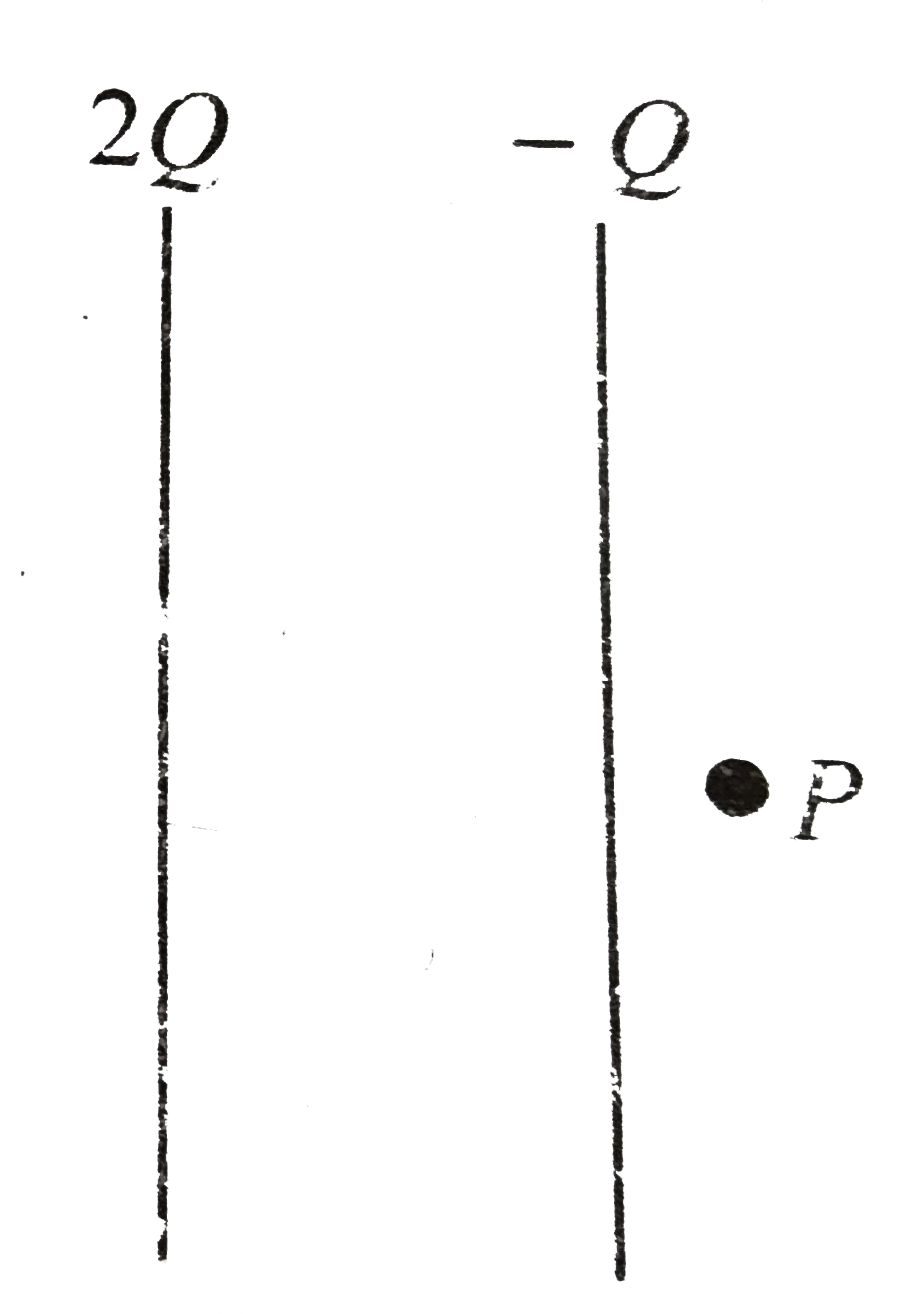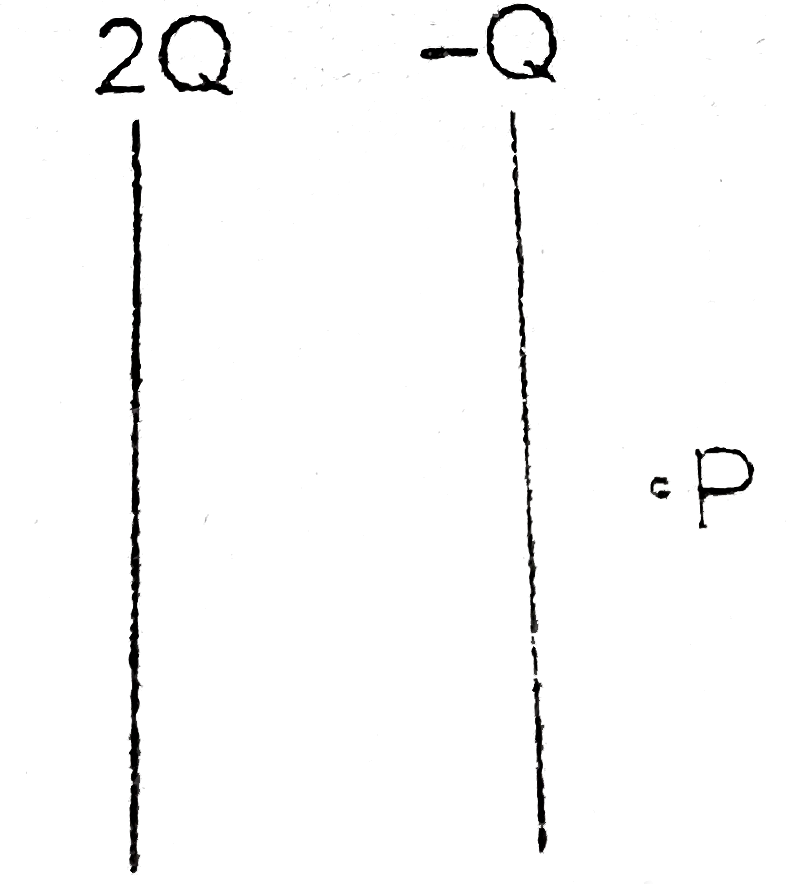One plate of a parallel plate capacitor is given a charge of 2μC. What charge will appear on four surfaces of the capacitor?
Let the charge be given to the plate A of the capacitor
As shown in the figure, let q be the charge appearing on the inner surface (2) of the plate A. Then, the charge on its outer surface (1) will be (2×10−6−q)C.
The induced charge on inner surface (3) of the plate B will be -q, and that on the outer surface (4) will be +q.

To find q, we will calcualte the electric field at point O inside the plate B.
Electric field due to surface 1, E1
=(2×10−6−q)2ε0A, towards right
Electric field due to surface 2, E2
=q2ε0A, towards right
Electric field due to surface 3, E3
=q2ε0A, towards left
Electric field due to surface 4, E4
=q2ε0A, towards left
As the point O lies inside the conducting plate, the electric field at this point will be zero.
E1+E2−E3−E4=0
net electric field at point O due to all surfaces is calculated as:
(2×10−6−q)2ε0A+q2ε0A−q2ε0A−q2ε0A=0
⇒(2×10−6−q)2ε0A−q2ε0A=0
⇒2×10−6−2q=0
⇒q=10−6C
∴ Charge on surface 1=2×10−6−10−6=+10−6C
Charge on surface 2=10−6C
Charge on surface 3=−10−6C
Charge on surface 4=+10−6C
Topper's Solved these Questions
- BOOK - MODERN PUBLICATIONCHAPTER - ELECTROSTATIC POTENTIAL AND CAPACITANCE EXERCISE - PRACTICE PROBLEMS 110videos
ELECTROSTATIC POTENTIAL AND CAPACITANCE
- BOOK - MODERN PUBLICATIONCHAPTER - ELECTROSTATIC POTENTIAL AND CAPACITANCE EXERCISE - PRACTICE PROBLEMS 221videos
ELECTROSTATIC POTENTIAL AND CAPACITANCE
- BOOK - MODERN PUBLICATIONCHAPTER - ELECTROMAGNETIC WAVESEXERCISE - CHAPTER PRACTICE TEST14videos
ELECTROMAGNETIC WAVES
- BOOK - MODERN PUBLICATIONCHAPTER - MAGNETISM AND MATTEREXERCISE - CHAPTER PRACTICE TEST FOR BOARD EXAMINATION16videos
MAGNETISM AND MATTER
Similar Questions
The negative plate of a parallel plate capacitor is given a charge of −20X10−8C. Find the charges appearing on the four surface of the capacitor plates.
 View Solution
View SolutionThe charges appearing on inner surfaces of a parallel plate capacitor are q_( i and )q_(2) . The charges appearing on outer surfaces of the capacitor are equal.Find the potential difference between plates of the capacitor if capacitances is C.
View Solution
Knowledge Check
- Question 1 - Select One
A parallel plate capacitor C has a charge Q. The actual charges on its plates are
AQ,QBQ/2, Q/2CQ,-QDQ/2. - Q/2 - Question 2 - Select One
The capacity of a parallel plate air capacitor is 10μF and it is given a charge of 40μC. The electrical energy stored in the capacitor is
A400 ergB600 ergC800 ergD900 erg - Question 3 - Select One
A parallel plate capacitor is charged. If the plates are pulled apart
Athe potential difference increasesBthe capacitance increasesCthe total charge increasesDthe charge and the potential difference remain the same
A charge of 1μC is given to one plate of a parailel - plate capacitor of capacitance 0.1μF and a charge of 2μC is given to the other plate . Find the potential difference developed between the plate .
View SolutionIf the plates of a parallel plate capacitor are not equal in area then quantity of charge
View SolutionIn figure , the plates of a parallel plate capacitors have unequal charges. Its capacitance is C. P is a point outside the capacitor and close to the plate of charge -Q. The distance between the plates is d. Then
 View Solution
View SolutionIn the figure shown the plates of a parallel plate capacitor have unequal charges. Its capacitance is 'C' P is a point outside the capacitor and close to the plate of charge −Q. The distance between the plates is 'd'
 View Solution
View SolutionOne plate of parallel plate capacitor is smaller than the other, the charge on the smaller plate will be.
View Solution
